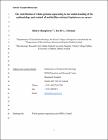| dc.contributor.author | Coleman, David | |
| dc.contributor.author | Humphreys, Hilary | |
| dc.date.accessioned | 2020-04-16T13:59:40Z | |
| dc.date.available | 2020-04-16T13:59:40Z | |
| dc.date.issued | 2019 | |
| dc.date.submitted | 2019 | en |
| dc.identifier.citation | Humphreys, H. & Coleman, D.C., Contribution of whole-genome sequencing to understanding of the epidemiology and control of meticillin-resistant Staphylococcus aureus, JOURNAL OF HOSPITAL INFECTION, 102, 2, 2019, 189 - 199 | en |
| dc.identifier.other | Y | |
| dc.identifier.uri | https://www.journalofhospitalinfection.com/article/S0195-6701(19)30055-6/fulltext | |
| dc.identifier.uri | http://hdl.handle.net/2262/92302 | |
| dc.description.abstract | In recent years, approaches to tracking the spread of meticillin-resistant Staphylococcus aureus (MRSA) as part of outbreak management have used conventional DNA-based methods, including pulsed-field gel electrophoresis and spa typing. However, when a predominant clone is present, these methods may be insufficiently discriminatory. A literature search was undertaken to highlight how whole-genome sequencing (WGS) has revolutionized the investigation of outbreaks of MRSA, including intrahospital spread and MRSA in the community, and to review its future potential. WGS provides enhanced isolate discrimination, as it permits the entire genomic DNA sequence of isolates to be determined and compared rapidly. Software packages used for the analysis of WGS data are becoming increasingly available. To date, WGS has been more sensitive in confirming outbreaks, often persisting for prolonged periods, previously undetected by conventional molecular typing. The evolving dynamic of spread from the community to hospitals, within and between hospitals, and from hospitals to the community is only becoming clear with WGS studies, and is more complex and convoluted than widely appreciated. Also, WGS can exclude cross-transmission, when isolates are different. The challenges now are to make WGS technology more amenable for routine use, and to develop an evidence-based consensus for sequence difference thresholds for isolates that are deemed to be part of the same outbreak, including protracted outbreaks. Using such data in a timely way will provide increased sensitivity in detecting cross-transmission events at an earlier stage, with the potential to prevent outbreaks, and have a positive impact on infection prevention and control. | en |
| dc.format.extent | 189 | en |
| dc.format.extent | 199 | en |
| dc.language.iso | en | en |
| dc.relation.ispartofseries | JOURNAL OF HOSPITAL INFECTION; | |
| dc.relation.ispartofseries | 102; | |
| dc.relation.ispartofseries | 2; | |
| dc.rights | Y | en |
| dc.subject | Whole-genome sequencing | en |
| dc.subject | MRSA | en |
| dc.subject | Bioinformatics | en |
| dc.subject | MRSA clones | en |
| dc.subject | Outbreaks | en |
| dc.subject | Acute hospital | en |
| dc.subject | Spread | en |
| dc.subject | Community | en |
| dc.subject | Long-stay residential units | en |
| dc.title | Contribution of whole-genome sequencing to understanding of the epidemiology and control of meticillin-resistant Staphylococcus aureus | en |
| dc.type | Journal Article | en |
| dc.type.supercollection | scholarly_publications | en |
| dc.type.supercollection | refereed_publications | en |
| dc.identifier.peoplefinderurl | http://people.tcd.ie/dcoleman | |
| dc.identifier.rssinternalid | 197904 | |
| dc.identifier.doi | http://dx.doi.org/10.1016/j.jhin.2019.01.025 | |
| dc.rights.ecaccessrights | openAccess | |
| dc.subject.TCDTheme | Immunology, Inflammation & Infection | en |
| dc.identifier.rssother | PII: S0195-6701(19)30055-6 | |
| dc.subject.TCDTag | Bioinformatics | en |
| dc.subject.TCDTag | EPIDEMIOLOGY | en |
| dc.subject.TCDTag | Genetic/Molecular epidemiology | en |
| dc.subject.TCDTag | Genomes, Genomics | en |
| dc.subject.TCDTag | METHICILLIN-RESISTANT STAPHYLOCOCCUS AUREUS | en |
| dc.subject.TCDTag | MOLECULAR EPIDEMIOLOGY | en |
| dc.subject.TCDTag | MRSA | en |
| dc.subject.TCDTag | MRSA clones | en |
| dc.subject.TCDTag | MRSA outbreaks | en |
| dc.subject.TCDTag | MRSA spread | en |
| dc.subject.TCDTag | Whole Genome Sequencing | en |
| dc.identifier.orcid_id | 0000-0003-1797-2888 | |
| dc.status.accessible | N | en |




